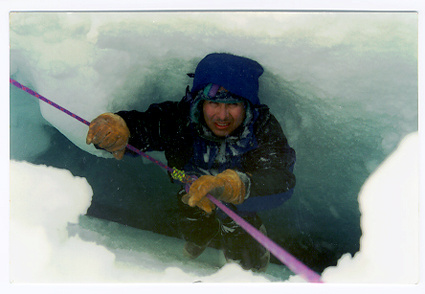|
Getting the word outExploratorium tells stories about the polar regions using multimedia approachPosted June 13, 2008
Two years ago, while aboard a Russian research vessel cruising around the South Shetland Islands, a chain of isles about 120 kilometers northwest of the Antarctic Peninsula, Cassandra Brooks sent detailed e-mails to friends and family about her first trip to the Antarctic. This past austral summer, Brooks, a graduate student in marine science at Moss Landing Marine Laboratories in California, returned to the Scotia Sea on the R/V Yuzhmorgeologiya to help survey krill populations, part of the U.S. Antarctic Marine Living Resources program. The information the scientists collect about the shrimplike crustacean will help create sustainable management practices of this important fishery. On this trip, Brooks wanted to bring more people along on the adventure, so she volunteered to work as a multimedia correspondent for the San Francisco-based science museum, the Exploratorium. (Read her blog “I’ve always strongly believed in outreach,” says Brooks, who plans to work eventually in science journalism. “I don’t really see the point in doing science if you’re not going to make that available for everybody. You use that [information] for management, of course, but I think you can help people make really good decisions, especially consumers if you educate them.” Mary Miller views the outreach supported by the Exploratorium as a way to give scientists a voice that might otherwise go unheard. “I think [young scientists] feel like they have a bigger purpose, a mission almost, to educate younger people and have people understand what they do,” says Miller, the principal investigator for an International Polar Year (IPY) project called Ice Stories, funded by the National Science Foundation. The project promotes public awareness about IPY Richard “Chico” Perales knows a bit about both regions. He worked a series of jobs for the U.S. Antarctic Program from 1990 to 2005, and started making trips north in 2003 supporting science in the Arctic. He is the only non-scientist sending blogs back from the field for the Exploratorium. (Read his blog “I thought it was a great opportunity,” Perales said over the phone from Barrow, Alaska, where he is currently involved in the planning and installation of infrastructure for a hydrology project that will help researchers understand the role of soil moisture in controlling ecosystem carbon balance. “I wanted to do [the Exploratorium reports] from a different angle.” Founded in 1969 by Frank Oppenheimer, the Exploratorium is a museum of science, art and human perception with a focus on public education. It’s been online since 1993, and its Web site averages more than 27 million visitors per year. “It’s been a really important part of the museum’s outreach to the world,” Miller says of the Exploratorium’s Web presence. “It’s not just about visitors coming in, but it’s about the museum going out.” Miller will lead a small team from the Exploratorium out to Antarctica during the 2008-09 summer field season to report on the variety of research under way. She last visited the continent in 2001 on a similar project that used the Web to educate and inform the public about polar research. “It’s amazing to me that you can walk down a hallway in Crary Lab [the main science building at McMurdo Station], and if there’s a door open, poke your head in and start talking to somebody, and all of a sudden you’re in the middle of some really extraordinary science story,” she says. Miller herself has a background in marine science, but like Brooks, decided to go into communications, attending a science journalism program at the University of California, Santa Cruz. She’s been at the Exploratorium for 17 years, and has worked on the Web end of things since 1996. “It’s been a continually evolving, fun thing because my position there is for the public understanding of science,” she says, explaining few museums cover current research like the Exploratorium. “What I try to do is work with research scientists, and when I go to different locations, I try to bring that alive to people. So if you read a newspaper story you have more context and background into what goes into discoveries.” |



For USAP Participants |
For The Public |
For Researchers and EducatorsContact UsNational Science FoundationOffice of Polar Programs Geosciences Directorate 2415 Eisenhower Avenue, Suite W7100 Alexandria, VA 22314 Sign up for the NSF Office of Polar Programs newsletter and events. Feedback Form |



